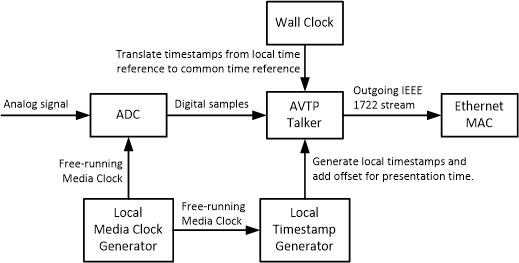SNAA333 April 2020 CDCE6214-Q1
- eAVB Media Clock Synchronization Using CDCE6214-Q1 Clock Generator
4.1 Talker and Presentation Time
A simplified Talker block diagram is shown below:
 Figure 4. AVB Talker Simplified Block Diagram
Figure 4. AVB Talker Simplified Block Diagram This diagram explains how the media clock source is embedded into AVTP packets. The media clock's source can be a simple free-running local oscillator, because the media clock does not need to lock to any reference, as long as the frequency of all media clocks in the same domain are synchronized. The media clock goes into a local timestamp generator that generates timestamps every certain number of media clock rising edges. These timestamps are generated based off of a local time reference. The Wall Clock then translates the local time based timestamps to gPTP timestamps. The AVTP Talker adds a fixed offset (typically the maximum delay between the Talker and all Listeners) and generates presentation timestamps.
The AVTP Presentation Time represents the gPTP time at which a designated media sample or event is transferred to the time-sensitive application within each Listener. This enables multiple Listeners to present data at the same time, regardless of the location of the Listeners in the network. The AVTP Presentation Time tells a Listener when to start processing the stream's data (for example, playing media) and is also used to recover the stream's media clock. To understand how to use Presentation time to recover the stream's media clock see Section 4.2.